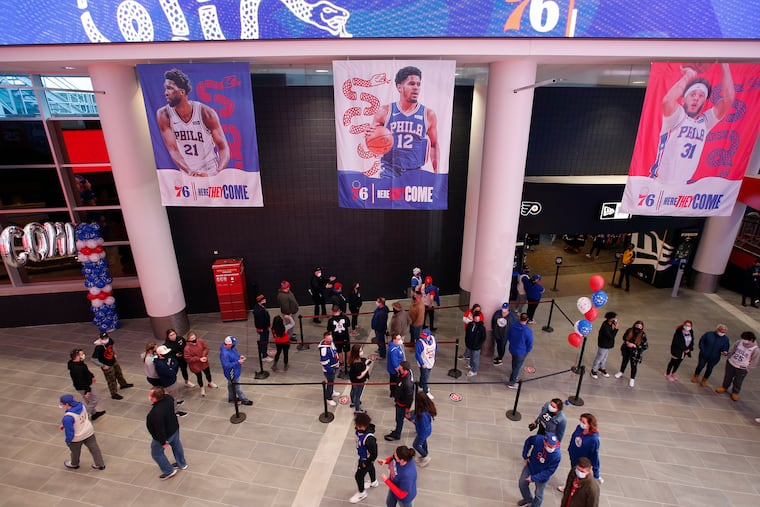In welcoming fans to the Wells Fargo Center, the Sixers took a necessary step toward normal | David Murphy
The Sixers played their first game in front of fans in 368 days. It went as well as anybody could have hoped.

Some form of normal returned on Sunday night, and it came as it often does, alive in all of the little things that once had been ambient noise. It was there in the oohs that swelled from the walls, and it was there in the aahs that descended in the opposite direction. It was there in the boos at the foul line, and in the woos at the scorers table, and in the low schizoid rumble of a hundred different conversations filling the quiet moments between audio-visual blasts.
To have been a citizen of the world over the last 12 months is to need no reminder of the little things that were lost. And, yet, here it was, two-and-a-half hours of mundane midseason basketball, an arena filled 15% to capacity, a seating bowl spaced like a Sudoku puzzle, all of it somehow making you feel like you’d spent three months floating in a sensory deprivation tank.
“When the fans came through, it kind of gave me chills,” said Chris Heck, the Sixers’ president of business operations and the man responsible for orchestrating the team’s first game in front of fans in 368 days. “Sometimes you get that with a great national anthem or a great intro or a great dunk. I’ve had that feeling a number of times over the years, but this is the first time I’ve had it in 12 months.”
» READ MORE: Ben Simmons, Sixers dunk San Antonio Spurs in front of 3,071 fans at Wells Fargo Center
It was abnormal enough to leave you wishing for a more traditional form of the status quo. The familiar artifacts of 2020 remain – the roped-off lines, the face shields, the attendant walking around the club level, doorknob to doorknob, a box of sanitizing wipes under his arm. Tickets were sold in blocks of two or four in the main seating bowl, each block spaced at least three seats apart in all directions. Concession stands were open, but masks were mandatory whenever food wasn’t being consumed. A couple of fans found out the hard way after pulling down their masks to cheer. Two strikes is the policy, an attendant informed them.
So, no, it was not normal, but it was necessary, and anybody who thinks otherwise should take a long look at the most recent trend lines and then compare them to the looks on the faces of the folks who milled the halls of the Wells Fargo Center on Sunday night. For the kids and teens and couples and fathers and mothers and sons, it may have been an evening of gratuitous fun. But it’s the wage-earning members of the micro-economy who felt these few hours most acutely. Ushers, security guards, cooks, servers, janitors, food runners, many of them working second jobs, all finally back on the job after a year of epic disruptions. Speak to them privately and they’ll tell you how badly they missed it, not just the paycheck but the sense of purpose, of connection, of playing a physical, tangible, bankable part in a process.
These things matter. The last year has been a philosophical crisis as much as it has been a crisis of public health. In modern-day America, a virus seized upon a host that was uniquely ill-equipped to deal not only with its calamitous physical toll, but also its implications. Most of us are used to living in a world where there are clear and definitive answers. For 12 months now, we have been living a real-life trolley dilemma, many of us forced for the first time to reckon with a reality that is inherently in conflict.
One year after the NBA was at the tip of the spear of a world shutting down, it is now tasked with helping society rebuild in itself a sense that life can safely go on. Current state and city guidelines limit capacity to 15%, but the Sixers sound optimistic that the number will grow as long as they show that they can manage the risk.
“You never know how you are going to feel until you are there,” Heck said. “I think we’ve all felt that over the last 12 months. Whether you’re in a grocery store, a place of worship, or even a casino, you don’t know how you’re going to feel until you see it. I know how we feel now after one half of one game and that is that we feel really, really good that we can provide good entertainment to our fans, they can provide a needed boost for our players, and we think we’re on a path to grow this bigger.”
A big step toward normal is normalizing such sentiments. The post-shutdown world is going to provide material for decades worth of doctoral dissertations on its second-order effects. But the need and opportunity for growth should be clear to all. Sunday night was a step in a direction that we all will eventually need to head. Here’s to hoping it’s another brick in the foundation upon which society can rebuild.
» READ MORE: After a year without jobs, stadium workers are eager to return to the stands with fans